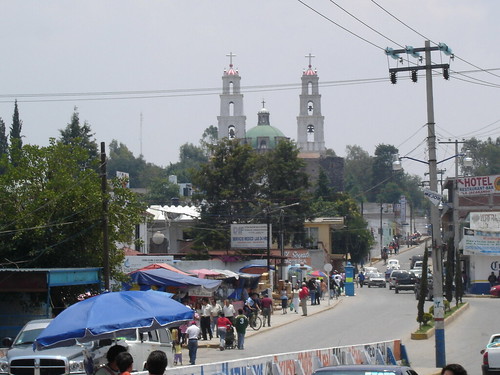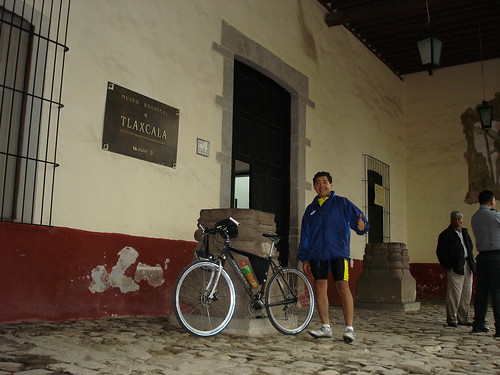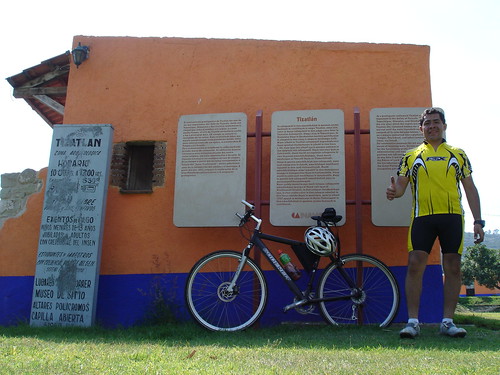Tula Archaeological Site (Hidalgo), 24.06.07
Map Navigation: This dynamic Trackmap shows the GPS track (red line) and some geo-referenced photos (red dots) of the cycling tour. Wheel up and wheel down your mouse to zoom in or zoom out the map. Click on any point in the map to center it on that point. Or just drag the map with your mouse. To see the photos, hoover the mouse over the red dots. Click on the photo to go to the picture page.

Photoset Map
Photoset Show
GPS Track: KMZ (Google Earth), or GPX (MapSource, et al).
GPS Cycling Data:



Distance: 193 Km, Total Ascent: 1100 m, Cycling Time: 8:02 hr, Avg. Speed: 24 Km/hr, Max Speed: 57.1 Km/hr, Energy Expended: 36 MJ, Cycling Power: 311 W.
Travel Report:
Owed to the fact that on the previous day I had to attend a late-night compromise, this ride started at the insane late hour of 12:00 !
I had decided for this ride to the Tula Archaeological Site, not to take the paid highway to Querétaro (as I had taken a lot of times this highway), riding instead by the old (and free) highway. Starting from Mexico City center, I rode towards Tlalnepantla, Cuautitlán, Teoloyucan, Huehuetoca, and Jorobas.
From Jorobas, I had to take a choice between 2 different paths: the paid highway (that I had used a lot of times), or the free road passing by the Tula Refinery. I choosed the last one, always wanting to know something new. But the road conditions were less than ideal. The asphalt carpet is eroded and full of holes, caused by the big trucks that roam freely on this highway.
The landscapes along the Refinery road are speechless ! Full desert ! I seldom ride on the northern side of Mexico City, but each time I do it, I always feel struck by the incredible vistas along the desert ! Accustomed as I am to the humid landscapes of the south and east part of my country, being in in the northern deserts resembles me like travelling in an entire different planet !
Unfortunately, my camera stopped working in Huehuetoca, since I was carrying it in the handlebar bag (lots of vibration), so I am not able to offer you a glimpse of those beautiful desert vistas.
Following the road ahead, after good 100 km, I could finally arrive at the Tula Archaeological Site, just 15 minutes later than last allowed entrance time (17:00). So, after crossing some words with the guard, I cycled my way back to Mexico City, arriving past 22:00 hr, under full night cover.
I hope to remake this travel next week, but departing now at 07:00, so I could finally enter at the beautiful Tula archaeological site. And now, with a working photo camera !
Thank you for reading. Till the next travel.



Distance: 193 Km, Total Ascent: 1100 m, Cycling Time: 8:02 hr, Avg. Speed: 24 Km/hr, Max Speed: 57.1 Km/hr, Energy Expended: 36 MJ, Cycling Power: 311 W.
Travel Report:
Owed to the fact that on the previous day I had to attend a late-night compromise, this ride started at the insane late hour of 12:00 !
I had decided for this ride to the Tula Archaeological Site, not to take the paid highway to Querétaro (as I had taken a lot of times this highway), riding instead by the old (and free) highway. Starting from Mexico City center, I rode towards Tlalnepantla, Cuautitlán, Teoloyucan, Huehuetoca, and Jorobas.
From Jorobas, I had to take a choice between 2 different paths: the paid highway (that I had used a lot of times), or the free road passing by the Tula Refinery. I choosed the last one, always wanting to know something new. But the road conditions were less than ideal. The asphalt carpet is eroded and full of holes, caused by the big trucks that roam freely on this highway.
The landscapes along the Refinery road are speechless ! Full desert ! I seldom ride on the northern side of Mexico City, but each time I do it, I always feel struck by the incredible vistas along the desert ! Accustomed as I am to the humid landscapes of the south and east part of my country, being in in the northern deserts resembles me like travelling in an entire different planet !
Unfortunately, my camera stopped working in Huehuetoca, since I was carrying it in the handlebar bag (lots of vibration), so I am not able to offer you a glimpse of those beautiful desert vistas.
Following the road ahead, after good 100 km, I could finally arrive at the Tula Archaeological Site, just 15 minutes later than last allowed entrance time (17:00). So, after crossing some words with the guard, I cycled my way back to Mexico City, arriving past 22:00 hr, under full night cover.
I hope to remake this travel next week, but departing now at 07:00, so I could finally enter at the beautiful Tula archaeological site. And now, with a working photo camera !
Thank you for reading. Till the next travel.








